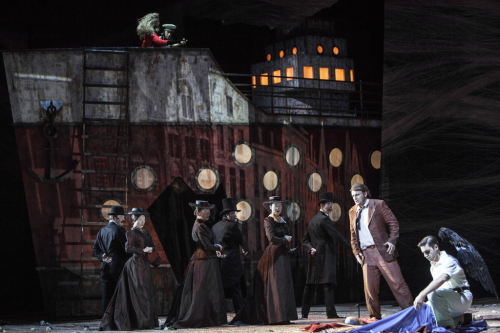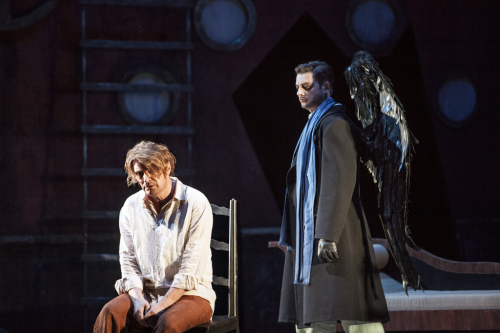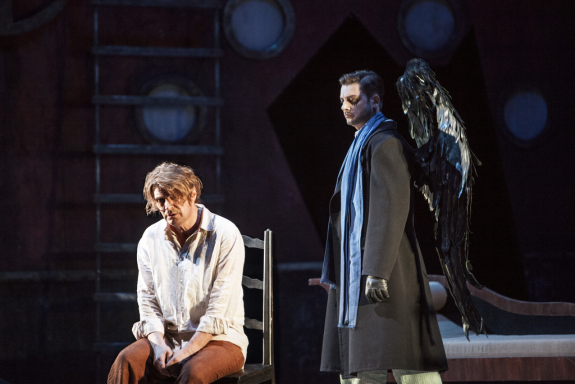 Germany Korngold, Die tote Stadt: Soloists, Chorus, Extra Chorus, Alsterspatzen (children and youth chorus) of Staatsoper Hamburg. Philharmonisches Staatsorchester Hamburg / Yoel Gamzou (conductor). Staatsoper Hamburg; 5.6.2024. (DMD)
Germany Korngold, Die tote Stadt: Soloists, Chorus, Extra Chorus, Alsterspatzen (children and youth chorus) of Staatsoper Hamburg. Philharmonisches Staatsorchester Hamburg / Yoel Gamzou (conductor). Staatsoper Hamburg; 5.6.2024. (DMD)

Production:
Director – Karoline Gruber
Set design – Roy Spahn
Costume design – Mechthild Seipel
Lighting design – Hans Toelstede
Choreography – Stefanie Erb
Dramaturgy – Kerstin Schüssler-Bach
Chorus director – Eberhard Friedrich
Children’s chorus director – Luiz de Godoy
Cast:
Paul – Klaus Florian Vogt
Marietta / Marie – Vida Miknevičiūtė
Frank / Fritz – Daniel Schmutzhard
Brigitta – Katja Pieweck
Juliette – Na’ama Shulman
Lucienne – Yeonjoo Katharina Jang
Victorin – Florian Panzieri
Count Albert – Aaron Godfrey-Mayes
Dreams constitute their own kind of reality, where nothing needs to comply with and follow the rationality we expect of daily life. Dreams are central to Korngold’s Die tote Stadt. In this revival of Hamburg State Opera’s 2015 production of this opera, the last production under the artistic management of the company’s then general music director Simone Young, director Karoline Gruber and her team made the oneiric nature of events and characters central to their approach.
The set by Roy Spahn represented a space in Paul’s mind. The walls were covered with a close-up of a woman’s hair, the floor looked like a sandy beach with all kinds of things scattered around, including occasional pieces of furniture, such as a table, chair and bed, reminiscent of Paul’s room. The dream-like nature became evident from apparently minor features: the floor only looked like sand in typical beach formation created by the waves, but from the way the singers walked on that surface it became clear that all was a solid surface – there was thus a difference between appearance and reality. As in reported dream experiences, characters merged and identities shifted. When Brigitta first appeared, possibly as herself, she was dressed as a waitress – as was Marietta at her first appearance. Then she changed into Marie. Marie/Marietta/Brigitta were pregnant at times. Until he became involved in the action, Paul sat on a chair near the front of the stage, with his back to the audience, observing what was happening in his inner space. Later, a large, ship-like object crashed through the paper wall (with Marie’s hair painted on to it) at the back of the stage towards the left, and Marietta’s troupe consisted of fantasy humanoid creatures, made up and moving like zombies (excellent choreography by Stefanie Erb!). Paul’s friend Frank grew wings for his appearance in Paul’s dream. When Paul realised the truth about his dream, the dream character of Marie/Marietta collapsed on stage, and Frank lost one half of his wings – a playful suggestion, at the very end, that the boundary between dreams and reality may not be as clear-cut as many assume.

This unassuming and imaginative staging provided the profound basis for a creative partnership with music and singing. Judging by his performance, Yoel Gamzou seems to be sensing – and hence conducting – music through his entire body. He explored and led the orchestra to bring forth the rich depths of Korngold’s score, the wide array of the expressions of Paul’s world, his dream, with all its ups and downs, its seemingly normal, controlled moments and the sudden shifts to emotional turmoil, in turn ranging from fairly moderate to excessively wild.
Gamzou was not obliged to restrict volume to allow this fine cast of singers to be heard. Na’ama Shulman, Yeonjoo Katharina Jang, Florian Panzieri and Aaron Godfrey-Mayes are members of the company’s International Opera Studio; they brought their fresh, strong voices to the smaller parts. Katja Piewek has been a member of the company since 1999, seen and heard in a wide range of smaller and larger parts (including Brangäne and Eboli); she sang Brigitta with a well-rounded, melodious sound. Daniel Schmutzhard as Frank/Fritz impressed not merely with his keynote aria ‘Mein Sehnen, mein Wähnen’. His dark baritone provided a particularly striking contrast to Klaus Florian Vogt’s typically bright voice. Vida Miknevičiūtė was excellent as Marietta/Marie. A fast vibrato is part of her voice and approach to singing; it was consistent and controlled and did not distract. The voice was strong across registers and volume, and Miknevičiūtė clearly relished singing with the orchestra at full throttle (it was never a competition). Vogt’s voice is ideally suited to the character and the music written for Paul. The high range of the voice, which constitutes the majority of Paul’s music, was crystal clear, ringing, carrying effortlessly through the entire opera house even at pianissimo level, simply unique. The development of Vogt’s middle register provides the necessary basis for these delirious, transcendent, beautiful passages. His recent experience with ‘heavyweight’ parts such as Tristan and Siegfried (in both Siegfried and Götterdämmerung) allowed him to work with the unleashed orchestra without sounding strained. Altogether a mesmerizing evening of great opera!
Daniel Meyer-Dinkgräfe
